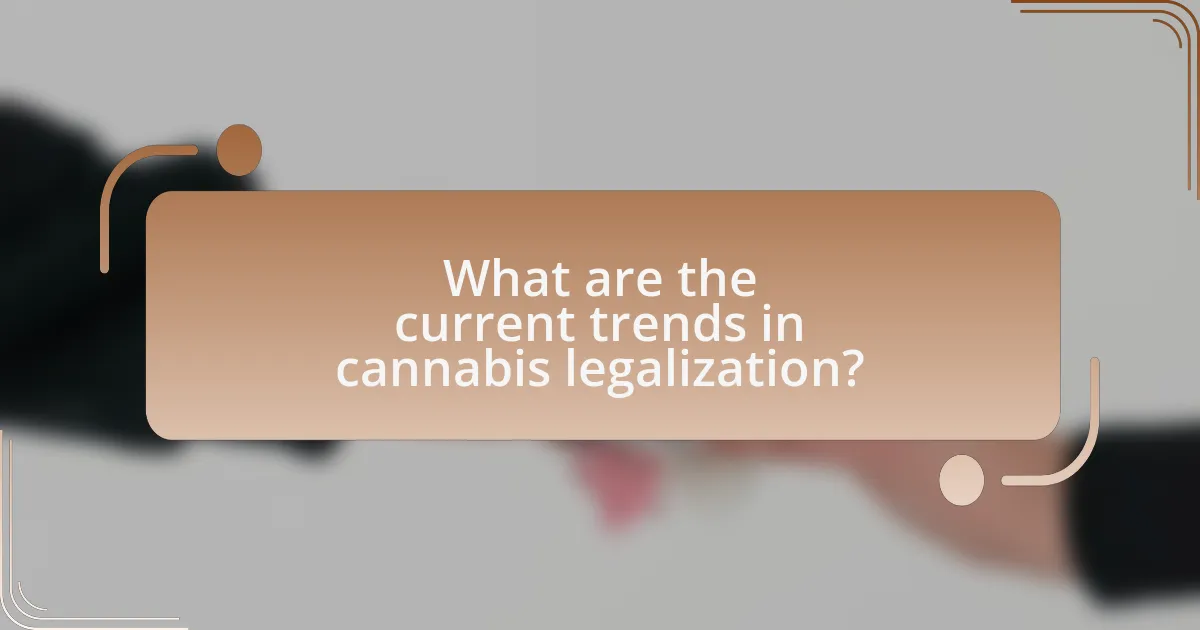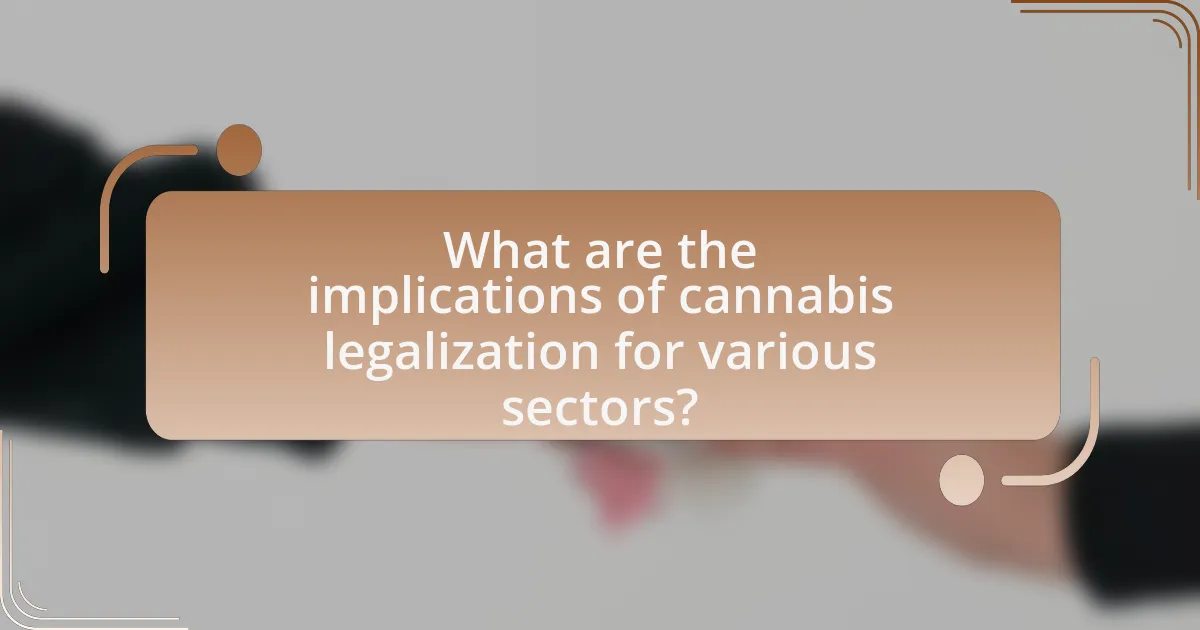The article focuses on the current trends and future predictions regarding cannabis legalization, highlighting significant developments in the United States and internationally. As of 2023, 23 states and Washington D.C. have legalized recreational cannabis, reflecting a cultural shift towards acceptance, supported by public opinion showing 68% favorability. Legislative changes have accelerated this trend, with states implementing social equity programs to address historical injustices. The article also examines the economic implications of legalization, including job creation and tax revenue generation, while addressing health and safety considerations that arise from increased cannabis use. Overall, it provides a comprehensive overview of the evolving landscape of cannabis legalization and its multifaceted impacts.

What are the current trends in cannabis legalization?
Current trends in cannabis legalization include an increasing number of U.S. states legalizing recreational and medical cannabis, with 23 states and Washington D.C. having legalized recreational use as of 2023. Additionally, there is a growing movement towards decriminalization and expungement of past cannabis-related offenses, reflecting a shift in public opinion favoring legalization. Recent polls indicate that approximately 68% of Americans support legalizing cannabis, highlighting a significant cultural change. Furthermore, international trends show countries like Canada and Uruguay leading in full legalization, while others are exploring medical cannabis frameworks, indicating a global shift towards more permissive cannabis policies.
How have recent legislative changes impacted cannabis legalization?
Recent legislative changes have significantly accelerated cannabis legalization across various jurisdictions. For instance, in 2021, states like New York and Virginia enacted laws to legalize recreational cannabis, reflecting a growing trend towards legalization. According to the National Conference of State Legislatures, as of October 2023, 21 states and Washington D.C. have legalized recreational cannabis, demonstrating a shift in public policy influenced by changing societal attitudes and economic considerations. These legislative changes have not only expanded access to cannabis but also generated substantial tax revenue, with states like Colorado reporting over $2 billion in tax revenue since legalization in 2014.
What states or countries have made significant progress in legalization?
Canada and several U.S. states have made significant progress in cannabis legalization. Canada legalized recreational cannabis nationwide in October 2018, becoming the second country in the world to do so after Uruguay. In the United States, states like California, Colorado, and Illinois have implemented comprehensive legalization measures, with California legalizing recreational use in 2016 and Illinois following suit in 2020, generating over $1 billion in sales in its first year. These examples illustrate a clear trend toward broader acceptance and legalization of cannabis in various regions.
How do public opinions influence legislative changes?
Public opinions significantly influence legislative changes by shaping the priorities and actions of lawmakers. When a substantial portion of the population expresses support for or against a particular issue, such as cannabis legalization, legislators often respond to these sentiments to align with their constituents’ views and secure electoral support. For instance, a Gallup poll in 2021 indicated that 68% of Americans favored legalizing cannabis, prompting several states to reconsider their laws and move towards legalization. This demonstrates that public sentiment can directly impact legislative agendas and outcomes, as elected officials seek to reflect the will of the people to maintain their political viability.
What role does social equity play in cannabis legalization trends?
Social equity plays a crucial role in cannabis legalization trends by addressing the historical injustices faced by marginalized communities due to cannabis prohibition. Many legalization efforts now include provisions aimed at ensuring that individuals from these communities have access to the cannabis industry, such as prioritizing licenses for minority-owned businesses and providing funding for education and training. For instance, states like California and Illinois have implemented social equity programs that allocate a percentage of cannabis tax revenue to support these initiatives, reflecting a commitment to rectify past harms and promote inclusivity in the emerging market. This focus on social equity not only fosters economic opportunities for affected communities but also enhances public support for legalization by demonstrating a commitment to justice and fairness.
How are marginalized communities being considered in legalization efforts?
Marginalized communities are being considered in legalization efforts through the inclusion of social equity programs aimed at addressing historical injustices. These programs often prioritize access to licenses and resources for individuals from communities disproportionately affected by past cannabis prohibition, which has led to significant disparities in wealth and opportunity. For example, states like California and Illinois have implemented measures that allocate a percentage of cannabis tax revenue to support these communities, providing funding for education, job training, and business development. Additionally, legislation often includes provisions to expunge past cannabis-related convictions, further acknowledging the impact of the war on drugs on marginalized populations.
What programs exist to support social equity in the cannabis industry?
Various programs exist to support social equity in the cannabis industry, including state-level initiatives like California’s Social Equity Program and Illinois’ Cannabis Equity Grant Program. These programs aim to provide financial assistance, training, and resources to individuals from communities disproportionately affected by cannabis prohibition. For instance, California’s program allocates funds to help applicants navigate the licensing process and offers technical assistance, while Illinois’ program provides grants to support equity applicants in establishing cannabis businesses. These initiatives are designed to rectify historical injustices and promote diversity within the cannabis sector.

What predictions can be made about the future of cannabis legalization?
Predictions about the future of cannabis legalization indicate a trend toward broader acceptance and legalization across various jurisdictions. As of 2023, over 40 U.S. states have legalized cannabis in some form, reflecting a significant shift in public opinion and legislative action. This trend is supported by data showing that 68% of Americans favor legalization, according to a Gallup poll conducted in 2021. Furthermore, international movements, such as Canada’s nationwide legalization in 2018 and ongoing discussions in countries like Germany and Mexico, suggest that more nations may follow suit. Economic factors, including tax revenue generation and job creation in legal markets, further bolster the case for legalization, as evidenced by Colorado generating over $2 billion in cannabis tax revenue since legalization in 2014. Overall, the trajectory points toward increased legalization, driven by public support, economic incentives, and changing social norms.
How might federal legalization in the United States evolve?
Federal legalization in the United States may evolve through a combination of legislative action, public support, and state-level precedents. As more states legalize cannabis for medical and recreational use, the pressure on federal lawmakers to align federal policy with state laws increases. For instance, as of October 2023, 23 states and Washington D.C. have legalized recreational cannabis, indicating a significant shift in public opinion and acceptance. This trend suggests that federal legalization could occur through comprehensive reform bills, such as the Cannabis Administration and Opportunity Act, which aims to decriminalize cannabis at the federal level and regulate it similarly to alcohol. Additionally, ongoing discussions about social equity and the economic benefits of legalization may further drive legislative changes, as evidenced by the projected $41.5 billion cannabis market in the U.S. by 2025.
What are the potential benefits of federal legalization?
Federal legalization of cannabis can lead to significant economic benefits, including increased tax revenue and job creation. For instance, states that have legalized cannabis have reported substantial tax income; Colorado generated over $1.7 billion in tax revenue from cannabis sales between 2014 and 2020. Additionally, federal legalization would facilitate a regulated market, reducing illegal sales and enhancing consumer safety. It would also allow for more extensive research into cannabis, potentially leading to medical advancements and improved public health outcomes. Furthermore, federal legalization could reduce the burden on the criminal justice system by decreasing arrests related to cannabis offenses, which disproportionately affect marginalized communities.
What challenges could arise during the federal legalization process?
Challenges that could arise during the federal legalization process include regulatory inconsistencies, opposition from various political groups, and potential conflicts with state laws. Regulatory inconsistencies may occur as federal agencies establish guidelines that differ from state regulations, leading to confusion and compliance issues for businesses. Opposition from political groups, particularly those with strong anti-drug stances, could hinder legislative progress and create a polarized environment. Additionally, conflicts with existing state laws could complicate enforcement and create legal ambiguities, as states may choose to maintain their own cannabis regulations despite federal changes. These challenges are evident in the ongoing debates and legislative efforts surrounding cannabis reform in the United States.
What international trends are influencing cannabis legalization?
International trends influencing cannabis legalization include the increasing acceptance of cannabis for medical use, the push for criminal justice reform, and the economic potential of cannabis markets. Countries like Canada and Uruguay have set precedents by fully legalizing cannabis, prompting others to reconsider their policies. Additionally, the World Health Organization’s recommendations for reclassifying cannabis have encouraged nations to explore legalization. Economic studies indicate that legal cannabis markets can generate significant tax revenue and job creation, further motivating governments to adopt more progressive cannabis policies.
Which countries are leading the way in cannabis reform?
Canada and Uruguay are leading the way in cannabis reform. Canada legalized recreational cannabis nationwide in October 2018, becoming the second country in the world to do so, while Uruguay was the first to legalize recreational cannabis in December 2013. Both countries have established regulatory frameworks that govern the production, distribution, and sale of cannabis, setting a precedent for other nations considering similar reforms.
How do international treaties affect national legalization efforts?
International treaties significantly influence national legalization efforts by establishing legal frameworks and obligations that countries must adhere to. For instance, treaties like the Single Convention on Narcotic Drugs of 1961 impose restrictions on the cultivation and distribution of certain substances, including cannabis, which can hinder a nation’s ability to legalize or regulate cannabis use. Countries that are signatories to such treaties face pressure to conform to international norms, which can delay or complicate domestic legalization initiatives. Additionally, the evolving nature of international treaties, such as the increasing calls for reform and decriminalization, can create opportunities for nations to reconsider their stance on cannabis legalization, as seen in countries like Canada and Uruguay that have navigated these international obligations to implement legal frameworks for cannabis.

What are the implications of cannabis legalization for various sectors?
Cannabis legalization has significant implications for various sectors, including healthcare, agriculture, and the economy. In healthcare, legalization can lead to increased research opportunities and the development of cannabis-based treatments, as evidenced by the growing number of studies exploring its medicinal benefits, such as pain relief and anxiety reduction. In agriculture, the legalization of cannabis creates a new market for farmers, allowing them to cultivate hemp and marijuana, which can diversify their crops and increase income; the U.S. hemp market alone was valued at approximately $1.1 billion in 2020. Economically, legalization can boost tax revenues for governments, as seen in states like Colorado, which generated over $387 million in tax revenue from cannabis sales in 2020. Additionally, the legalization can impact the criminal justice system by reducing incarceration rates for cannabis-related offenses, contributing to social equity initiatives. Overall, the implications of cannabis legalization are multifaceted, affecting health, agriculture, and economic structures.
How will the cannabis industry impact the economy?
The cannabis industry will significantly impact the economy by generating substantial tax revenue, creating jobs, and stimulating local businesses. In states where cannabis is legalized, tax revenues have reached billions; for example, Colorado collected over $1.7 billion in cannabis tax revenue from 2014 to 2021. Additionally, the industry has created hundreds of thousands of jobs, with estimates suggesting that legal cannabis could generate over 1 million jobs in the U.S. by 2025. This growth supports ancillary businesses, such as retail, agriculture, and technology, further enhancing economic development.
What job opportunities will arise from cannabis legalization?
Cannabis legalization will create numerous job opportunities across various sectors. The legal cannabis industry is projected to generate over 1 million jobs in the United States by 2025, according to a report by Leafly. These opportunities will include roles in cultivation, processing, distribution, retail, and compliance. Specifically, positions such as cannabis growers, extraction technicians, dispensary staff, and regulatory compliance officers will be in high demand as states implement legal frameworks for cannabis sales and distribution. Additionally, ancillary services such as marketing, legal consulting, and security will also see growth, further expanding the job market associated with cannabis legalization.
How will taxation from cannabis sales affect state budgets?
Taxation from cannabis sales will positively impact state budgets by generating significant revenue. For instance, states like Colorado have reported over $1 billion in cannabis tax revenue since legalization in 2014, which has been allocated to education, healthcare, and infrastructure projects. This influx of funds can help alleviate budget deficits and support public services, demonstrating that regulated cannabis markets can provide a substantial financial boost to state economies.
What health and safety considerations arise from cannabis legalization?
Health and safety considerations arising from cannabis legalization include potential increases in impaired driving, public health impacts from increased usage, and the need for regulation of product quality and labeling. Impaired driving risks are significant, as studies indicate that cannabis use can impair motor skills and reaction times, leading to higher accident rates; for instance, a report from the National Highway Traffic Safety Administration found that cannabis was involved in 12% of fatal crashes in states where it is legal. Public health impacts may include increased rates of cannabis use disorder and mental health issues, as evidenced by research published in the Journal of the American Medical Association, which noted a rise in cannabis-related emergency room visits following legalization. Additionally, the regulation of cannabis products is crucial to ensure safety, as unregulated products may contain harmful contaminants; the Colorado Department of Public Health and Environment reported that 30% of cannabis products tested contained pesticides or other harmful substances.
How will legalization affect public health policies?
Legalization will significantly impact public health policies by necessitating the development of new regulations and frameworks to address cannabis use. As seen in states like Colorado and Washington, legalization has led to the implementation of health education programs aimed at informing the public about responsible use and potential health risks associated with cannabis consumption. Furthermore, public health policies will likely shift to include monitoring and research on the effects of cannabis on various demographics, particularly youth and vulnerable populations, as evidenced by studies indicating increased usage rates among adolescents in legalized areas. This shift will require collaboration between health departments, policymakers, and community organizations to ensure that public health initiatives effectively address the changing landscape of cannabis use.
What measures can be taken to ensure safe consumption of cannabis?
To ensure safe consumption of cannabis, individuals should adhere to dosage guidelines, use lab-tested products, and avoid mixing cannabis with other substances. Following dosage guidelines helps prevent overconsumption, which can lead to adverse effects; for instance, starting with a low dose and gradually increasing it allows users to gauge their tolerance. Using lab-tested products ensures that consumers are aware of the cannabinoid content and the absence of harmful contaminants, as verified by independent testing facilities. Additionally, avoiding the combination of cannabis with alcohol or prescription medications reduces the risk of negative interactions, which can enhance impairment and lead to unsafe situations.
What best practices should stakeholders consider in the legalization process?
Stakeholders should prioritize comprehensive stakeholder engagement in the legalization process. This involves actively involving community members, industry experts, and policymakers to gather diverse perspectives and foster transparency. Research indicates that inclusive dialogue can lead to more effective regulations and increased public support, as seen in the legalization efforts in Canada, where extensive consultations contributed to a well-rounded framework. Additionally, stakeholders should implement evidence-based policy development, utilizing data from jurisdictions with existing legalization to inform decisions. For instance, studies from states like Colorado demonstrate the importance of analyzing economic impacts and public health outcomes to create balanced legislation. Finally, ongoing education and training for law enforcement and regulatory bodies are essential to ensure proper implementation and compliance with new laws, as highlighted by the challenges faced in states that rushed the legalization process without adequate preparation.


